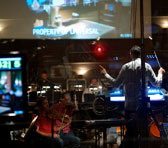13 June 2013
'The orchestral default' and other topics on DeBreved blog
 Image: Tim Davies conducting in the studio
Image: Tim Davies conducting in the studio © Larry Mah
I have a unique job: I orchestrate music and conduct orchestras
in Hollywood. Not something I thought I would be doing back when
I was playing drums in Brisbane rock bands! It has given me the
rare opportunity to regularly work and experiment with
professional orchestras. If I wonder what some technique or
colour might sound like, I can usually find a project that will
let me try it out. I've been able to learn what works, and what
doesn't, through doing it. I have always been fascinated by
orchestration, and over the years have noticed a lot of things
that are glossed over, wrong, or not mentioned at all in the
standard orchestration texts, particularly with regard to the way
we notate scores.
I have considered writing a book about orchestration and notation
for quite a while. The problem with this idea is time; it would
be a while before I got everything I wanted to say organised. It
came to me that a blog format would be ideal, and let me publish
as I go. So I have recently launched DeBreved. Think of
it as 'the missing chapters' of your orchestration textbooks.
It's meant to clarify some existing concepts and conventions, and
challenge some others. The foundation of my blog is the concept
of 'the orchestral default'. The following is the first article
where this concept is explained.
The Orchestral Default
In order to notate in a concise and effective manner, one has to understand how an orchestra will interpret any particular dynamic, rhythm, or articulation. For instance, what happens if you give the violins a naked whole note and a piano dynamic marking? Even with a minimum of information, the orchestra will still impart some life to that note. Now what if you add an articulation or hairpins? What happens at shorter rhythms? What will a pattern of eighth notes sound like at different dynamics or with different articulations? Keep adding and taking away all possible dynamics and articulations and think about how they modify the default. When you develop a better understanding of what orchestral players will do naturally, you will discover a lot of the things you have been writing in your scores are not necessary.
When we put something new in front of an orchestra, the players will have no performance practice reference, as they would in the case of a piece by Mozart, Tchaikovsky, or Prokofiev. We must understand, then, how the orchestra will interpret the notation when they have no reference; what is the default? Default playing styles are a little different for each instrument, of course, as they are often rooted in the physics of playing that instrument. Understanding these defaults is critical to clean notation.
Having orchestrated hundreds of hours of music and conducted hundreds more in the studio from both my scores and others', I have a pretty good idea of what needs to be on the page and what can be dispensed with. I have done experiments where I take the same section of music and write it a few ways to see what happens. By leaving some sections with minimal dynamics and articulation marked, I have worked out the default performance style.
What you will find is that the orchestra does not need to be programmed like a computer, where you must fill in every line of code or it will stop. It is a living organism that thinks for itself and is capable of filling in many details, in ways we could never even notate. The programming, in other words, has already been done. The best part about this is that it means the orchestra is very predictable. The art lies in knowing how to exploit these predictable behaviours to get the musical results you want.
For more articles, follow this link to Tim Davies's DeBreved blog.
AMC resources
Tim
Davies - AMC profile
'Confessions of an orchestrator' - a feature article on
Resonate by Tim Davies
Further links
DeBreved blog by Tim Davies
Tim
Davies Big Band
© Australian Music Centre (2013) — Permission must be obtained from the AMC if you wish to reproduce this article either online or in print.
Tim Davies is an Australian orchestrator, arranger, and conductor based in Los Angeles. His credits include films (Jack Reacher, Hangover III, Smurfs 2), video games (Batman: Arkham City, Infamous 2, The Last of Us), and work for recording artists including Amy Winehouse, Nas, and Glee's Matthew Morrison. He also leads and writes for the Tim Davies Big Band, for which he received a Grammy nomination in 2010.
Comments
Be the first to share add your thoughts and opinions in response to this article.
You must login to post a comment.